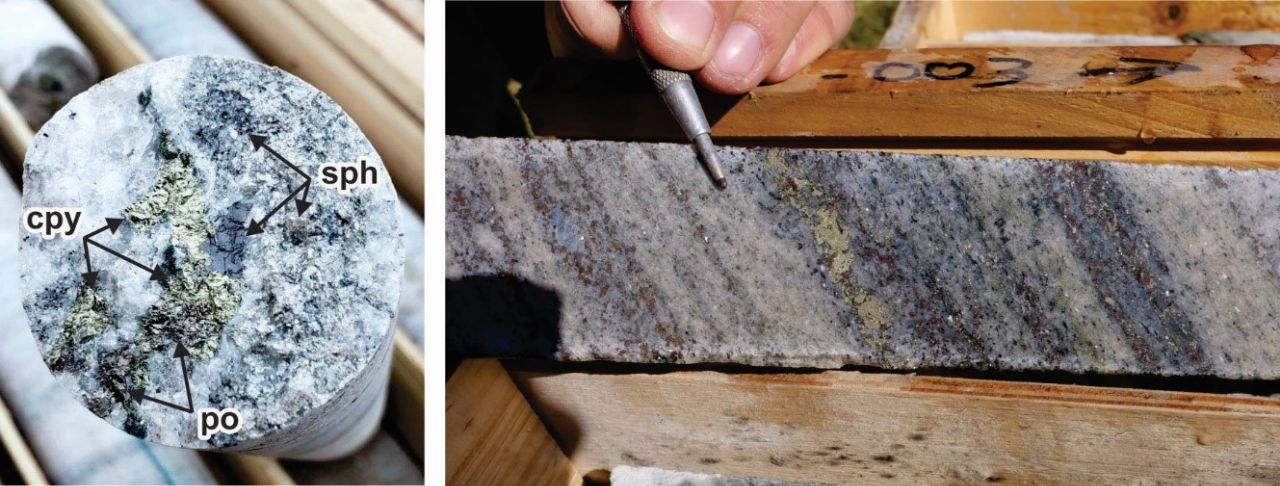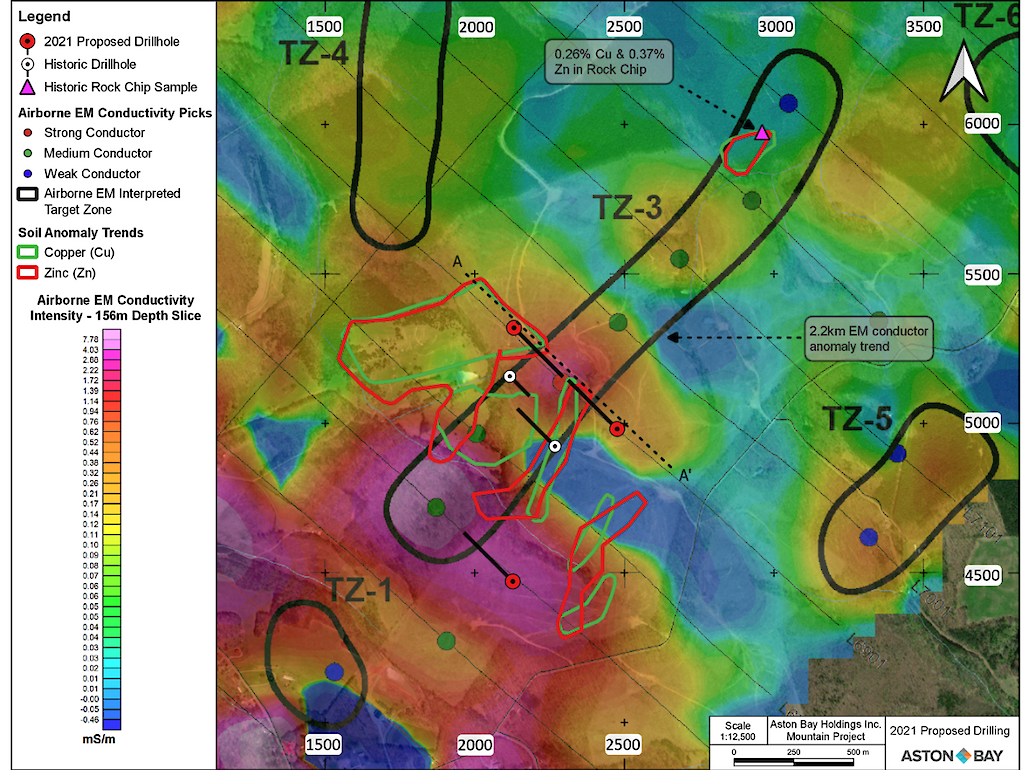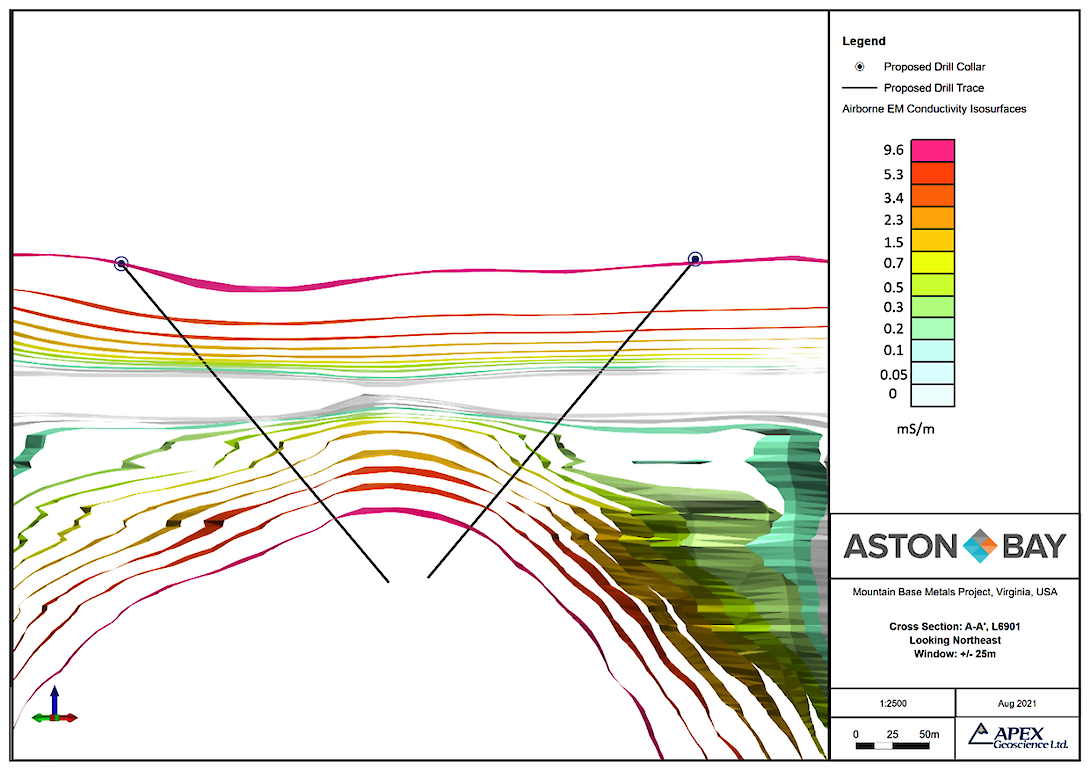Projects
Mountain Project and Base Metals Belt
Historical Exploration Highlights
- 1,713 acres surrounding recently discovered trend of polymetallic VMS and/or SEDEX/BHT-style mineralization.
- Limited historic exploration due to rare bedrock exposure (typically ≤1%) and extensive weathering (saprolite).
- Modern exploration in 1990’s by BHP identified the Blue Ridge terrane as permissive to host significant massive sulfide deposits.
- 11 core holes drilled on area properties; nine of the 11 historic holes intersected notable amounts of disseminated, vein-type, and massive base metal mineralization within marbles and schists.
- Significant highlights from that drilling include:
- 2.77% Cu, 0.94% Zn, 0.54% Pb over 5m, and
- 1.17% Cu, 5.23% Zn, 0.90% Pb over 2.25m
- The historic drilling results indicate that the stratigraphy in the project area contains mineralization consistent with the SEDEX/BHT type and the potential to host significant and economic Cu-Zn-Pb-Ag deposits of this type.
Overview
The Mountain Base Metals Project is located on 2,072 acres (835 hectares) of private land with direct access to both highway and rail transportation. Several electromagnetic (EM) and magnetic anomalies have been delineated by historic airborne and ground geophysical surveys on the property, coincident with areas of anomalous copper and zinc in rock chip and soil analyses.
The highest priority target is an airborne EM conductor anomaly 1.4 miles (2.2 kilometres) in strike length, contained entirely within the property and confirmed by well-defined ground EM anomalies. The conductor is also coincident with anomalous surficial rock chip analyses of up to 2,556 ppm Cu and 3,695 ppm Zn. Two historic drill holes targeted the anomaly, yielding 1.12% Zn and 0.74% Pb over a 4.6 metres (m) interval in core in 2013 and 0.82% Zn over a 0.43m core interval in 1999. The conductive anomaly has not been explained by results from the drilling, however, and subsequent geophysical reinterpretations suggest neither drill hole bisected the anomaly. The conductor remains untested, presenting a compelling target for significant base metals mineralization that Aston Bay plans to drill as part of a proposed summer drill program.
The Mountain Base Metals Project sits within a 60-mile (96 kilometre) belt with numerous historic stratabound lead, zinc, copper, barite, iron and manganese occurrences in a metamorphosed section of rift-related sedimentary, volcanic and intrusive rocks highly prospective for volcanogenic massive sulfide (VMS) and sedimentary exhalative (SEDEX) styles of mineralization. Negotiations to partner with landowners of prospective parcels in other portions of the belt are ongoing.
Recent Exploration
In August 2021, Aston Bay commenced a 1,500 metre (m) diamond drill program on the Mountain Base Metals Project in South Central Virginia, USA.
The drill program comprised of initial drill testing of several electromagnetic (EM) and magnetic anomalies delineated by reinterpretations of historic airborne and ground geophysical surveys on the property (Figure 1). The highest priority target (TZ-3) is an airborne EM conductor anomaly 2.2 kilometers (km) in strike length, contained entirely within the property and confirmed by well-defined ground EM anomalies (Figure 2). The conductor is also coincident with anomalous surficial soil anomaly trends and rock chip analyses of up to 0.26% Cu and 0.37% Zn.
Two historic drill holes targeted the anomaly, yielding 1.12% Zn and 0.74% Pb over a 4.6 m interval in core in 2013 and 0.82% Zn over a 0.43m core interval in 1999. The historical drilling did not fully explain the conductivity anomalies as subsequent geophysical reinterpretations suggest neither drill hole intersected the anomaly. Furthermore, the historical drilling only tested the TZ-3 conductor on a single section and the remainder of the 2.2km strike length of the feature represents a compelling target with respect to base metal mineralization on the property.
Downhole EM surveys will be conducted on all drillholes. Fixed loop TDEM (time domain electromagnetic method) surficial surveys are planned for secondary targets on the property.
Figure 1. 2021 proposed drill collars over an EM conductivity depth slice of 156m. Section line A-A’ corresponds to Figure 2.
Figure 2. Cross Section A-A’. Proposed drill holes intersecting strongly conductive EM anomaly.
In November 2021, Aston Bay expanded its diamond drill program from 1,500 metres to 2,500 metres. Copper and zinc mineralization has been encountered in all of the 2021 drillholes. The mineralization intersected in the drilling comprises stacked zones of disseminated and semi-massive chalcopyrite and sphalerite, with pyrite and pyrrhotite, hosted within metamorphosed carbonate rocks. These zones vary up to 20 metres in apparent thickness (core length), with thinner zones of more concentrated disseminated and semi-massive sphalerite- and chalcopyrite-bearing mineralization on the meter to sub-meter scale. Deep in the drillholes (below 300 meters depth), similar sulfide mineralization has been intersected in quartz veins and zones of silicification, potentially representing a feeder zone. Together, these styles of mineralization suggest a SEDEX (sedimentary exhalative) deposit model.
An example of the copper and zinc mineralization from hole ABM21-003 is presented in Figure 3.

Figure 3: Banded disseminated sulfide mineralization in drill core, Mountain Base Metals Project, Central Virginia (cpy = chalcopyrite, sph = sphalerite, po = pyrrhotite). Drillhole ABM21-003, approximately 265 meters down hole. Core diameter 47 millimeters (1.8 inches).


